Consecrated in June 1798, the Trafalgar Cemetery, Gibraltar, then known as Southport Ditch Cemetery contains only two graves of men that died in the Battle of Trafalgar
By Nick Nutter | Updated 14 Jun 2022 | Gibraltar | Places To Go |
Login to add to YOUR Favourites or Read Later
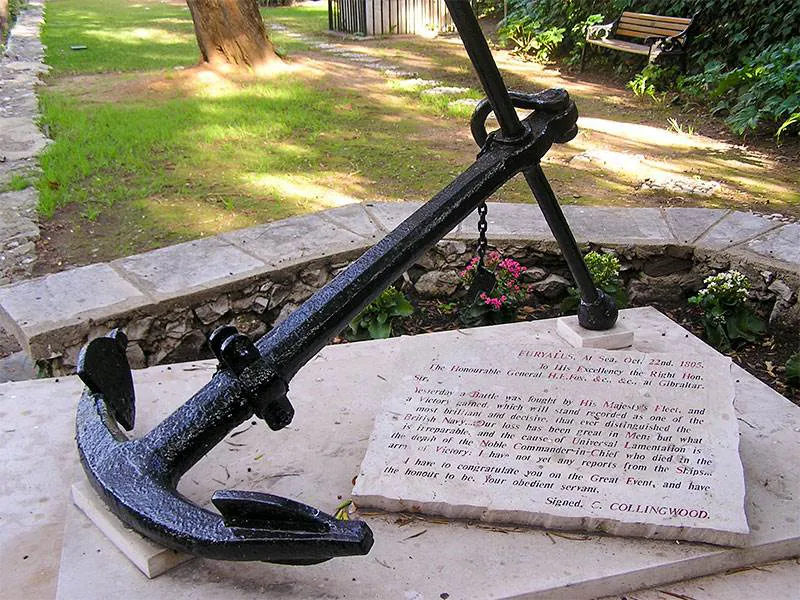
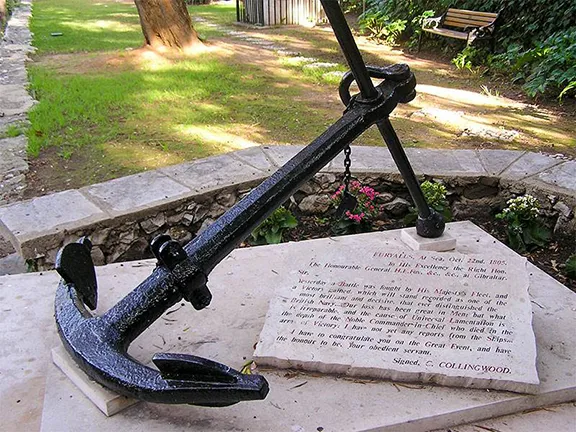
Few people want to die unremembered. In most cases, the funeral service is attended by family members and the ceremony gives closure too them. For the families of many of those buried at the Trafalgar Cemetery in Gibraltar that was not possible. Gibraltar was a military base and the families were hundreds or thousands of miles away, not even aware of the death of their husband, father or son until weeks after the event. It was left to colleagues and friends to provide a fitting memorial for the deceased. They choose to do that by recording the historic moment of death providing future generations with a snapshot of history and a reminder of the deceased's ‘finest hour’.
Consecrated in June 1798, the Trafalgar Cemetery, Gibraltar, then known as Southport Ditch Cemetery, was only in use for 16 years, until 1814. A plaque on a wall at the cemetery mistakenly gives the dates as 1708 to 1835, confusion possibly caused by the Southport Ditch Cemetery once having been attached to St. Jago’s Cemetery, sometimes called Deadman’s Cemetery. St. Jago’s was on the ‘inside’ of the section of Charles V wall that abuts the Trafalgar Cemetery.
Despite its name, the Trafalgar Cemetery in Gibraltar only has two men interred there who died as a result of that naval battle out of a total of 430 British deaths.
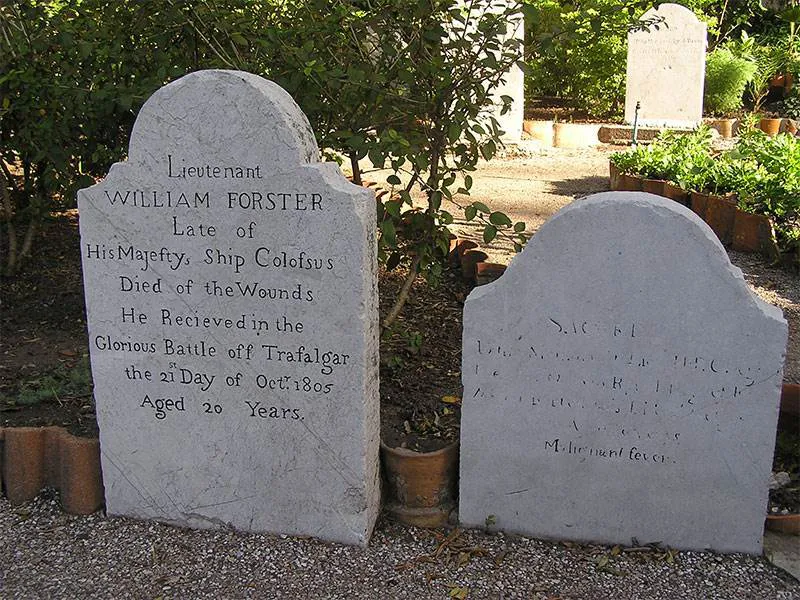
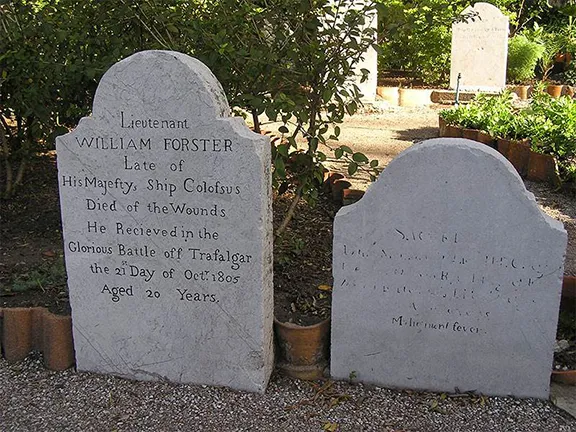
The headstones of Lieutenant William Forster and Captain Thomas Norman stand together.
Lieutenant Forster served on HMS Colossus, a frigate of 74 guns launched in 1803. She was known as a large 74 because she carried 24 pounder cannon on her upper gun deck as opposed to the usual 18 pounders. At the Battle of Trafalgar, her Captain was James Nicoll Morris. Colossus was in Collingwood’s lee column. During the engagement, she fought the French 74, Swiftsure and became entangled with another French 74, Argonaute. The Spanish 74, Bahama joined the melee and Argonaute broke free. Shortly afterwards Bahama surrendered to Colossus after losing her main mast and then Swiftsure did likewise after losing both main and mizzen. The carnage during this action can only be imagined, and it was to prove fatal to Lieutenant William Forster aged 20 years who died of his wounds later the same day and was buried at Gibraltar..
Captain Thomas Norman of the Royal Marine Corps served on HMS Mars, another 74. During the battle, Mars took fire from five French and Spanish 74s and was heavily damaged. After the battle, the Mars carried a distinguished prisoner, the French Admiral Villeneuve, Commander of the French fleet, who had been captured when his flagship, Bucentaure, was taken. Captain Thomas Norman was wounded during the action but took 44 days to die of ‘a fever wound’.
Collingwood’s dispatch following the battle was printed in the Gibraltar Chronicle and is a masterpiece of British understatement. It is reproduced on a stone plaque in the cemetery.
EURYALUS, AT SEA, OCTOBER 22, 1805.
Sir,
Yesterday a Battle was fought by His Majesty s Fleet, with the Combined Fleets of Spain and France, and a Victory gained, which will stand recorded as one of the most brilliant and decisive, that ever distinguished the BRITISH NAVY.
The enemy’s Fleet sailed from Cadiz, on the 19th, in the morning, Thirty Three sail of the Line in number, for the purpose of giving Battle to the British Squadron of Twenty Seven, and yesterday at Eleven A.M. the contest began, close in with the Shoals of Trafalgar.
At Five P.M. Seventeen of the Enemy had surrendered, and one (L’Achille) burnt, amongst which is the Sta Ana, the Spanish Admiral Don D’Aleva mortally wounded and the Santisima Trinidad. The French Admiral Villeneuve is now a Prisoner on board the Mars; I believe Three Admirals are captured.
Our loss has been great in Men; but what is irreparable, and the cause of Universal Lamentation is the Death of the Noble Commander in Chief, who died in the Arms of Victory; I have not yet any reports from the Ships, but have heard that Captains Duff and Cook fell in the Action.
I have to congratulate you upon the Great Event, and have the Honour to be,
(Signed) C.COLLINGWOOD
His Excellency, the Right Hon. The Hon. Gen. H. E. Fox
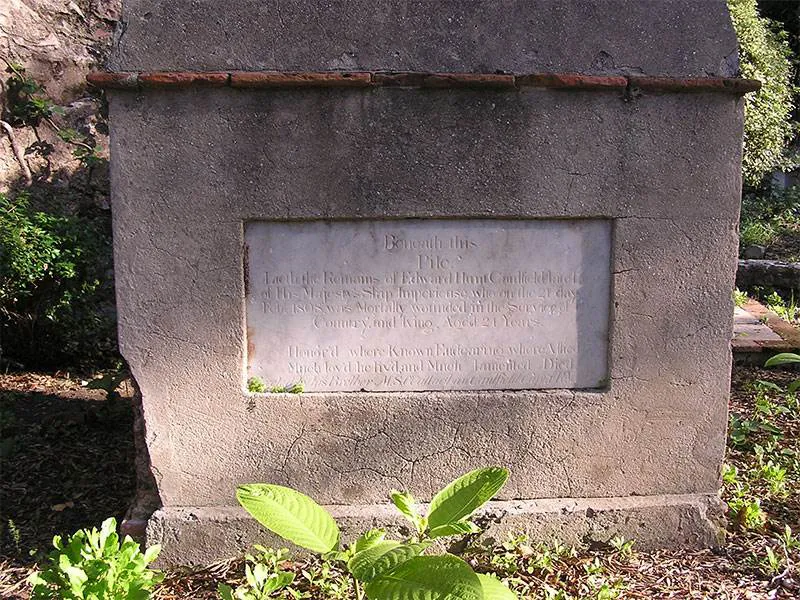
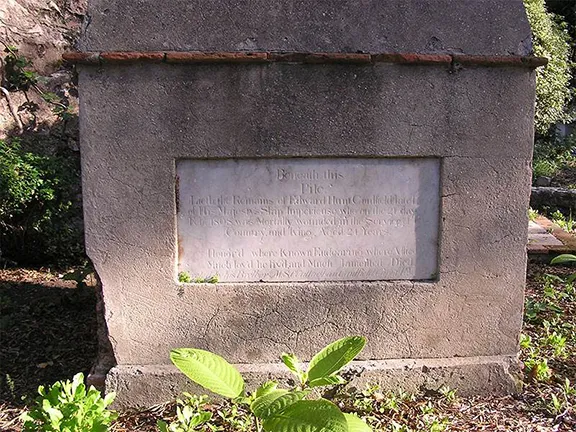
Some of the characters, now only remembered by their headstones, have inspired authors and filmmakers.
HMS Imperieuse was built as the ‘Medea’ in Ferrol, northern Spain and captured by the British during the ambushing of the neutral Spanish treasure fleet off Cap Finisterre in 1804 by a squadron led by Rear-Admiral Alexander Cochrane. This large and very sea-handy Spanish frigate was taken into British service and refitted at Falmouth as a 38-gun, 5th-rate frigate. She was renamed ‘Imperieuse’ and the command given to Admiral Cochrane’s nephew, the dashing frigate commander Captain Thomas Cochrane later 10th Earl of Dundonald. His First Lieutenant was Edward Hunt Caulfield. Imperieuse engaged in many of Lord Cochrane’s most daring and famous actions. In one such action, Lieutenant Caulfield was mortally wounded whilst the Imperieuse was engaging a French privateer off the coast of Almeria in February 1808.
While Lieutenant Edward Hunt Caulfield is remembered forever in the Trafalgar Cemetery, Captain Thomas Cochrane lives on as Jack Aubrey in Patrick O’Brian’s novels.
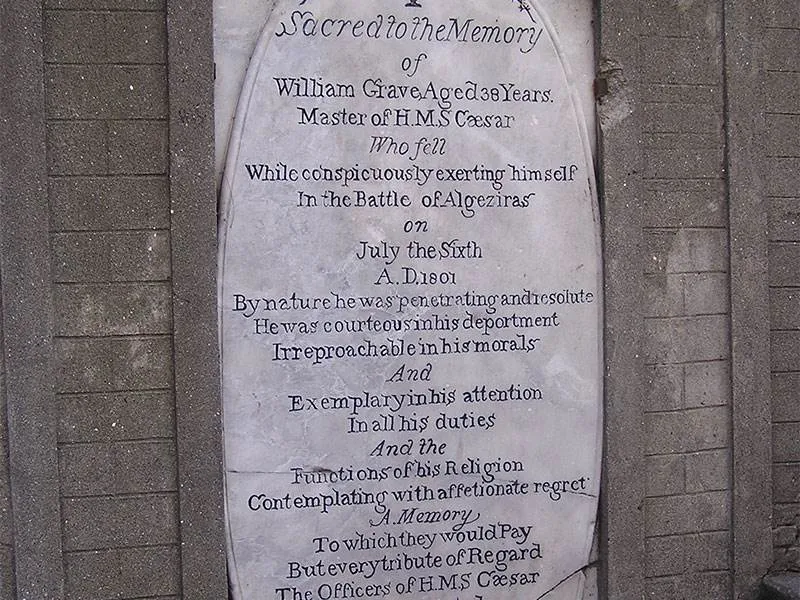
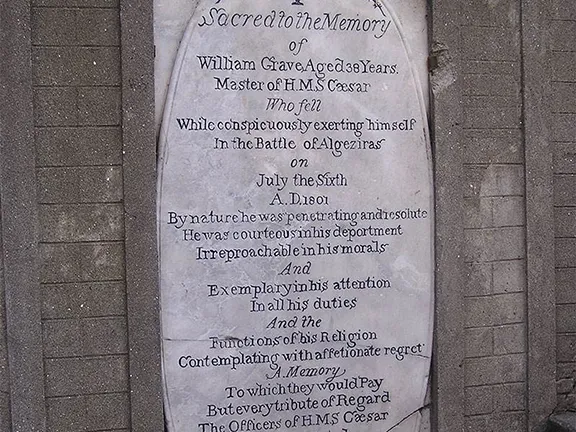
Not all naval actions lead to such glorious victories as Trafalgar as the monument to William Grave, Master of HMS Caesar, reminds us. In July 1801 the French Admiral Linois tried to enter the harbour at Cádiz with three ships of the line and one frigate but, finding it blockaded by a British squadron, made for Algeciras harbour which, at that time, was protected by four Spanish forts. At that period of the Napoleonic Wars Spain was an uneasy ally of France. Under the watchful eyes of the British on Gibraltar Admiral Linois successfully anchored his small fleet in Algeciras Bay.
On the 6th July, Admiral Sir James Saumarez with six ships of the line sailed out of Gibraltar to attack the French fleet. Saumarez flew his flag on the 80 gun HMS Caesar. The captain was Captain Jahleel Brenton and the Master was William Grave. The attack failed due to the heavy fire from the Spanish forts, light winds and shoals in the bay. HMS Hannibal one of the five 74 gunships ran aground and was captured. During the short action, the British lost 121 killed and 240 wounded, one of whom was William Grave whose ship had been in the thick of the battle. The English retreated to Gibraltar to repair the extensive damage to their ships while Admiral Linois re-floated the ships that he had beached during the action to prevent them from being taken.
On the 12th July the French fleet, now reinforced by one French and five Spanish ships of the line left Algeciras for Cádiz pursued by Saumarez. The French/Spanish fleet proved faster than the English ships so Saumarez gave his fastest ship. HMS Superb, 74 guns, his permission to chase and attack the enemy at will.
Superb caught up with the Spanish rear-guard just after nightfall and sailed between the San Hermenegildo and the Real Carlos, both of 112 guns. Captain Richard Goodwin Keats opened fire on both ships as he slipped between them. The Spanish, not realising the Superb had now gone ahead, fired on each other resulting in the loss of both ships. Keats went on to attack and capture the French St. Antoine, 74 guns. This action proved a significant victory for the English who only suffered a further 17 killed and 100 wounded. The combined French and Spanish losses amounted to 2,000, 1,700 of whom were killed when the Real Carlos and San Hermenegildo blew up.
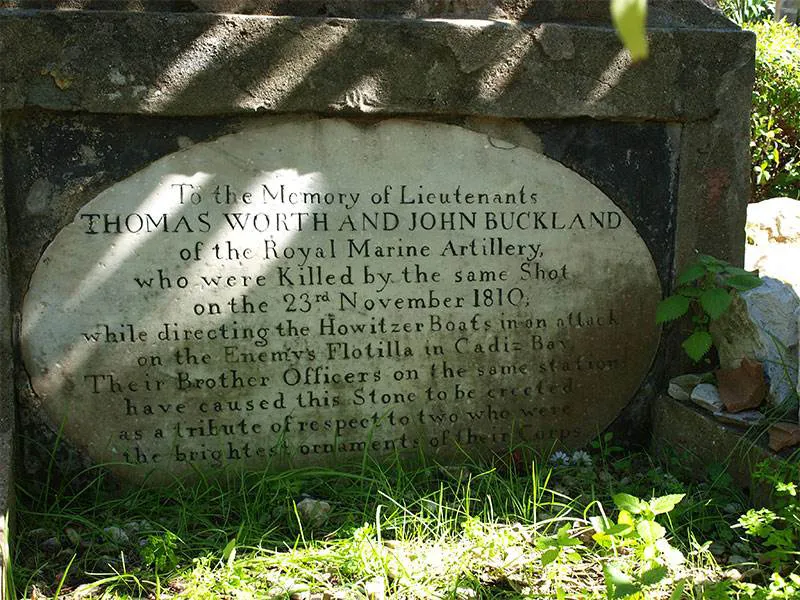
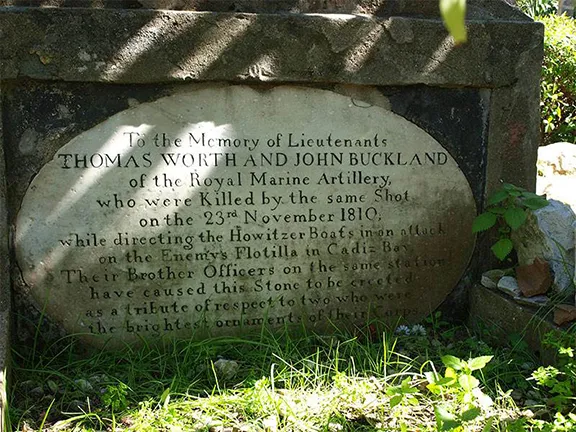
In the early 19th century, Gibraltar was a vital, strategic naval base. The ships and men based here played an essential role in the history of the day.
In February 1810, during the Peninsular War, the French besieged Cádiz that, following the fall of Madrid, had become the Spanish seat of power. 60,000 French troops in entrenchments at Chiclana, Puerto Real and Puerto de Santa Maria faced 2,000 Spanish troops who, as the siege progressed, were reinforced by another 10,000 Spanish as well as British and Portuguese soldiers. Any relief had to come by sea, and much of that came from Gibraltar.
The defence of Cádiz was one of the most critical campaigns during the war. Keeping Cádiz out of enemy hands preserved the Spanish monarch. The French occasionally managed to break through the British naval blockade and insert a warship into Cádiz Bay from where they would bombard the city. It was during one such action on the 23rd November 1810 that Lieutenants Thomas Worth and John Buckland of the Royal Marine Artillery were killed by the same shot fired by a French frigate. At the time they were serving a gun on one of the howitzer boats that were used against the French positions. They are buried in the same grave, together in death as they were in action.
It was not until the French were defeated at Salamanca in 1812 by the Duke of Wellington that the siege was lifted as the French were forced to retreat from Andalucia.
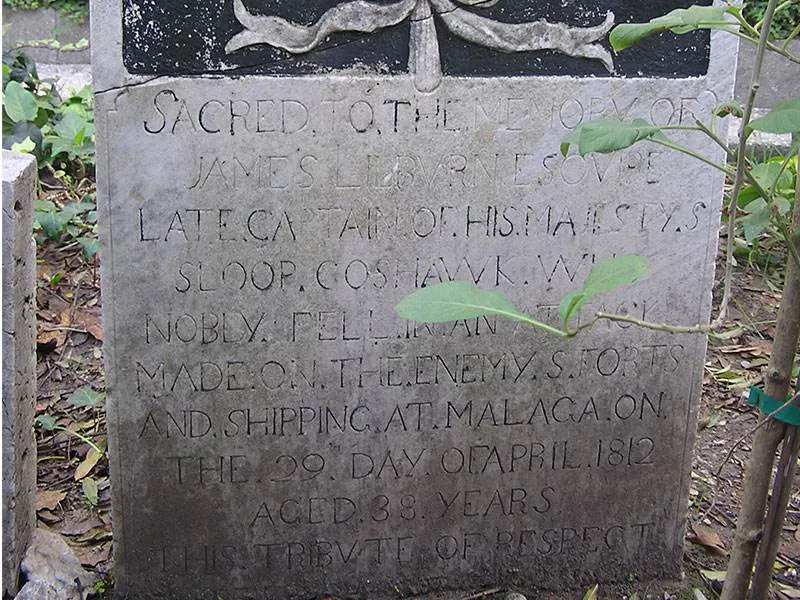
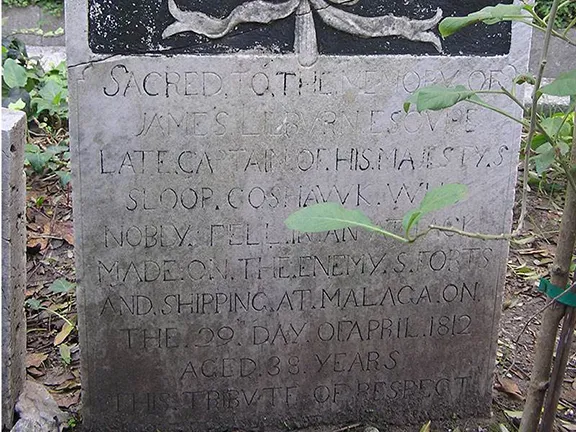
Málaga had been occupied by the French since they marched through on their way to Cádiz in 1810. The city was held by the 6th Regiment of Infantry of Joseph Napoleon’s army. Joseph was Napoleon’s brother who had been installed as King of Spain in 1808.
In 1812 it was time to restore Málaga to the Spanish and on the 29th April that year an action took place off Málaga that has few references in any history book. The taking of Málaga was a combined army and naval battle, the army marching on the city by land supported by artillery fire supplied from naval ships offshore whose primary targets were the fortifications around the city and any French shipping they found at the anchorage. One of the naval vessels taking part was the Goshawk, a 16 gun sloop that was of shallow enough draught to approach inshore. Unfortunately, during the action, her captain was killed and now rests at the Trafalgar Cemetery.
The inscription reads ‘James LILBURN, Captain, HM Sloop Goshawk, who nobly fell in an attack made on the enemy’s forts and shipping at Málaga, 29th April 1812, aged 38 years. Erected by the officers of the sloop.’
For opening times of Trafalgar Cemetery, click here